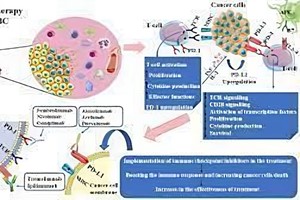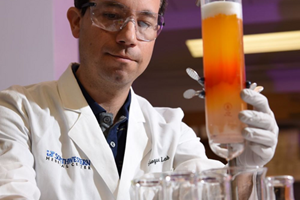Women with prior diagnoses of melanoma, ovarian cancer or uterine cancer had higher levels of “forever chemicals” and other toxic compounds in their blood, scientists determined in a new nationwide analysis.
Their study, published in the Journal of Exposure Science and Environmental Epidemiology, assessed potential links between hormone-related cancers and three classes of probable endocrine disruptors: per- and polyfluoroalkyl substances (PFAS), phenols and parabens.
Notorious for their persistence in both the environment and the body, PFAS have been linked to a variety of cancers and other illnesses. These so-called forever chemicals are found in a variety of household products, such as nonstick pans, waterproof apparel and cosmetics.
Common types of phenols, meanwhile, include bisphenol A (BPA), a common ingredient in polycarbonate plastic; benzophenone-3, a sunscreen agent; and triclosan, a microbicide used in home cleaning products.
Parabens — such as methylparaben, propylparaben, butylparaben and ethylparaben — are used as preservatives in cosmetics, pharmaceuticals, foods and beverages.
“PFAS and phenol chemicals appear to disrupt hormone function in women,” Amber Cathey, an assistant research scientist at the University of Michigan School of Public Health and first author of the study, said in a statement.
Such disruption, Cathey explained, constitutes “one potential mechanism that increases the odds of hormone-related cancers in women.”
To investigate the potential association between these compounds and hormone-related cancers, the scientists combed through data from the 48,712 adult participants in the 2005-2018 National Health and Nutrition Examination Survey.
The researchers then identified concentrations of seven types of PFAS and 12 phenols and parabens in blood and urine samples, as well as self-reported diagnoses of melanoma and cancers of the thyroid, breast, ovary, uterus, testicles and prostate.
The narrowed-down dataset included 8,010 men and 8,686 women in the PFAS analysis and 5,084 men and 5,344 women in the phenol and paraben analysis.
Ultimately, the authors found that women who had a previous melanoma diagnosis were more likely to exhibit higher levels of several types of PFAS — PFDE, PFNA and PFUA — as well as certain phenols, including BP3 and two others, known as DCP24 and DCP25.
In men, on the other hand, heightened blood levels of PFDE, PFNA and PFUA were not linked to greater odds of previous melanoma diagnoses, the authors noted.
Previous incidence of ovarian cancer was associated with increased levels of DCP25, BPA and BP3 in women, while past uterine cancer was connected to higher concentrations of PFNA.
Conversely, the authors found that women with higher levels of ethylparaben showed reduced odds having had uterine cancer in the past.
Both DCP24 and DCP25 showed positive associations with the odds of every cancer type evaluated, especially among women, according to the study. The scientists attributed this link in large part to previous breast and ovarian cancer diagnoses.
The fact that several PFAS were associated with greater odds of prior melanoma cases among women only — and that certain PFAS and phenols showed links to past ovarian cancer — indicates that these compounds may be causing sex-specific effects, the authors stressed.
As far as the melanoma connection is concerned, the scientists explained that because these tumor cells have estrogen receptors, environmental contaminants that mimic estrogenic activity — such as PFAS, potentially — could be fueling this cancer’s growth.
“These findings show that PFAS and phenols are potential environmental risk factors for cancer risk in women,” senior author Max Aung, an assistant professor at the University of Southern California’s Keck School of Medicine, said in a statement.
“Our study can be used to help prioritize which chemicals to investigate and mitigate exposure to as we continue working to reduce cancer risk,” Aung added.
The authors not only identified sex-based distinctions, but they also found certain differences among women of different races and ethnicities. Overall, they observed that white women exhibited greater odds of previous cancer diagnoses with higher PFAS exposure.
Meanwhile, Black and Mexican American women were more likely to have a prior cancer diagnosis alongside heightened exposure to phenols and parabens, according to the study.
“Future studies should build on this work to explore intersecting social identities, such as immigrant status, educational attainment and neighborhood factors,” Aung said.
Such information, Aung added, could help scientists and policymakers “better understand how to identify high-risk groups to strengthen prevention and intervention efforts.”











